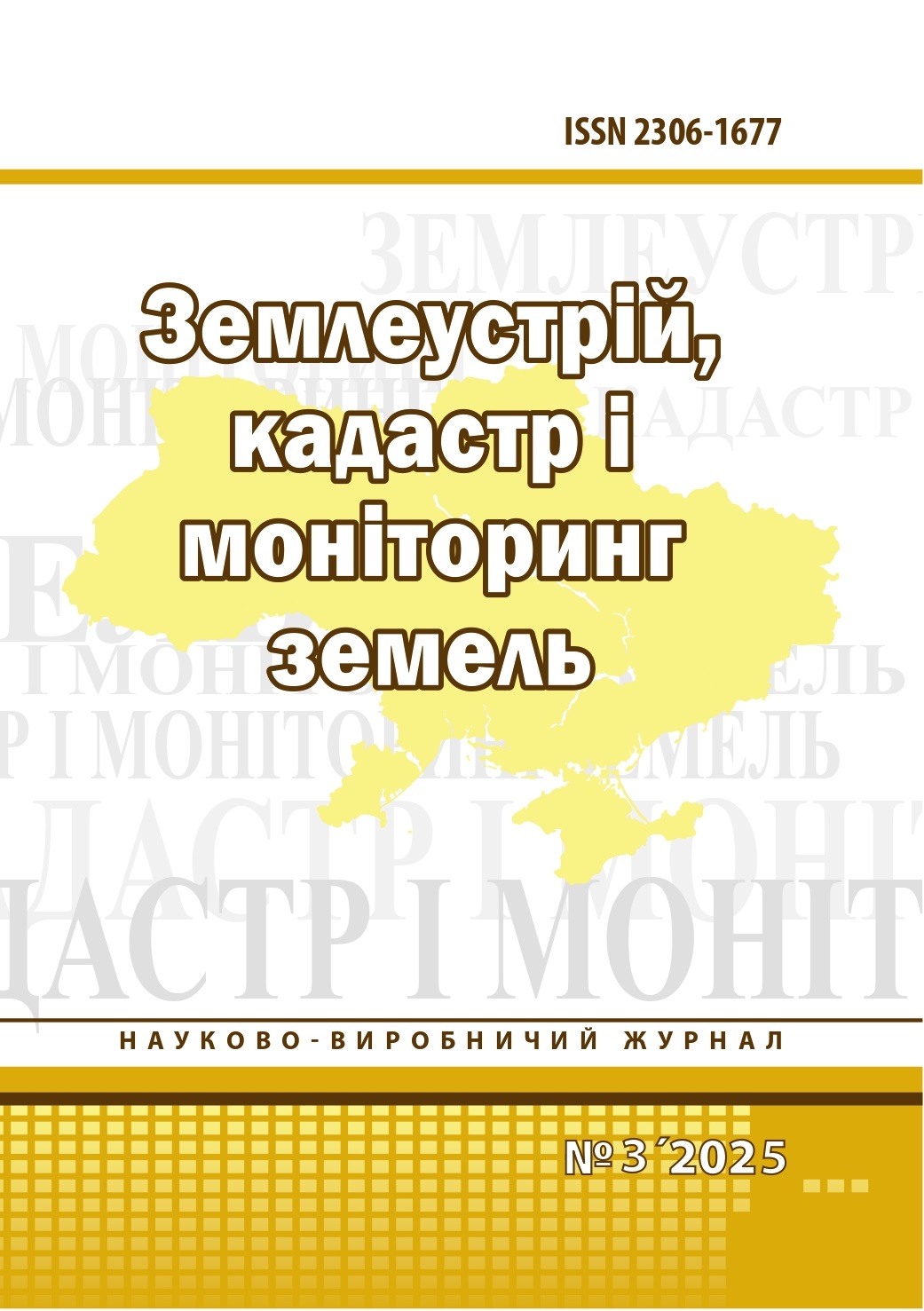Онтологія меж у системі сучасного землеустрою: від геометрії до режиму прав і цінностей
DOI:
https://doi.org/10.31548/zemleustriy2025.03.01Ключові слова:
межа, землеустрій, онтологія простору, LADM, інституційні режими, права й обмеження, 3D/4D-кадастр, інтероперабельність, value capture, просторове врядуванняАнотація
Стаття концептуалізує поняття «межа» в сучасному землеустрої як інституційно-режимну категорію, що перевищує геометричне трактування лінії поділу. На основі порівняльно-історичного та інституційного аналізу, нормоорієнтованого моделювання і формальної онтологізації (LADM) обґрунтовано перехід від матеріально-геометричної до режимної онтології простору, де межа функціонує як подія-відношення, що конституює права, обмеження, відповідальності та рентні потоки. Ідентифіковано чотири структурні рівні межі — матеріальний, правовий, інформаційний, екологічний — і показано їх супервенійні зв’язки та причинний вплив процедурної валідності даних на легітимність режимів. Сформульовано принципи онтологічного дизайну меж (конститутивність процедури, багатомодусність, адаптивність, метричність якості, сумісність і пріоритети, ціннісна прозорість), що уможливлюють інтеграцію правових норм, просторових даних та механізмів управління цінністю землі. Практична корисність полягає у переході від «реєстру ліній» до динамічної режимної моделі простору для кадастрових і планувальних систем, підвищенні якості рішень, мінімізації конфліктів і прозорому розподілі вигод. Робота позиціонується як внесок у становлення теорії сучасного землеустрою як фундаментальної дисципліни; анонсовано подальші публікації щодо формалізації режимів, GeoBIM-інтеграції та процедур оцінки легітимності.
Ключові слова: межа; онтологія простору; землеустрій; LADM; інституційні режими; права й обмеження; 3D/4D-кадастр; інтероперабельність; value capture; просторове врядування.
Посилання
1. Slanski, K. E. (2003). The Babylonian Entitlement Narûs (Kudurrus). Journal of Cuneiform Studies. Available at: https://www.bu.edu/asor/pubs/jcs/52/slanski.pdf
2. Writings of the Roman Land Surveyors: Introduction, Text, Translation and Commentary (Corpus Agrimensorum Romanorum). (2000). London: Society for the Promotion of Roman Studies. Available at: https://www.powells.com/book/writings-of-the-roman-land-surveyors-9780907764281
3. Corpus Agrimensorum Romanorum. (n.d.). Wikipedia. Available at: https://en.wikipedia.org/wiki/Corpus_Agrimensorum_Romanorum
4. Jones, M. J. (2018). Domesday Book: An early fiscal, accounting narrative? Accounting History Review. Available at: https://www.sciencedirect.com/science/article/abs/pii/S0890838917300628
5. Domesday and Taxation. (n.d.). Oxford Academic. Available at: https://academic.oup.com/book/33115/chapter/283464476
6. UK Parliament. (n.d.). Enclosing the Land. Available at: https://www.parliament.uk/about/living-heritage/transformingsociety/towncountry/landscape/overview/enclosingland/
7. Oxford Centre for Global History. (n.d.). Enclosing the English Commons: Property, Productivity and Power. Available at: https://globalcapitalism.history.ox.ac.uk/files/case26-enclosingtheenglishcommonspdf
8. Degrave, A. (2024). Evidence from the French Napoleonic Cadaster. TSE Working Paper. Available at: https://www.tse-fr.eu/sites/default/files/TSE/documents/doc/wp/2024/wp_tse_1530.pdf
9. 15th September 1807: the Napoleonic land registry was created. (n.d.). Available at: https://napoleon-en-seineetmarne.fr/en/15th-september-1807-napoleonic-land-registry-was-created
10. Department for Infrastructure and Transport (South Australia). (n.d.). Indefeasibility (Torrens Title). Available at: https://www.dhud.sa.gov.au/what-we-do/ORG/land-titling/indefeasibility
11. Williamson, I., Enemark, S., Wallace, J., & Rajabifard, A. (2010). Land Administration for Sustainable Development. FIG/ESRI Press. Available at: https://www.fig.net/resources/publications/otherpub/Land_Administration_for_Sustainable_Development.pdf
12. Williamson, I. (2001). The Evolution of Modern Cadastres. Proc. FIG. Available at: https://www.fig.net/resources/proceedings/fig_proceedings/korea/full-papers/pdf/session6/williamson.pdf
13. Tomlinson, R. (1967). An Introduction to the Geo-Information System of the Canada Land Inventory. Available at: https://www.geostrategis.com/CLI-reports/CGIS-Tomlinson-1967.pdf
14. Esri. (2012). Origins of the Canada Geographic Information System. ArcNews. Available at: https://www.esri.com/news/arcnews/fall12articles/origins-of-the-canada-geographic-information-system.html
15. USGS. (n.d.). Landsat Missions. Available at: https://www.usgs.gov/landsat-missions
16. NASA/GSFC. (n.d.). Landsat Science — History. Available at: https://landsat.gsfc.nasa.gov/satellites/history/
17. UNECE. (1996). Land Administration Guidelines (ECE/HBP/96). Available at: https://www.unece.org/fileadmin/DAM/hlm/documents/Publications/land.administration.guidelines.e.pdf
18. UNECE. (2005). Land Administration in the UNECE Region: Development Trends 1996–2005. Available at: https://unece.org/fileadmin/DAM/hlm/documents/Publications/landadmin.devt.trends.e.pdf
19. FAO. (2012). Voluntary Guidelines on the Responsible Governance of Tenure of Land, Fisheries and Forests. Available at: https://www.fao.org/4/i2801e/i2801e.pdf
20. UNCCD/FAO. (2022). Technical Guide on the Integration of the VGGT. Available at: https://www.unccd.int/sites/default/files/2022-05/cb9656en.pdf
21. ISO. (2012). ISO 19152:2012 Geographic information — Land Administration Domain Model (LADM). Available at: https://www.iso.org/standard/51206.html
22. ISO. (2024–2025). ISO 19152-1:2024…-5:2025 Geographic information — LADM (2nd ed.). Available at: https://www.iso.org/obp/ui/en/
23. FIG. (2024). News: ISO LADM Edition II. Available at: https://www.fig.net/news/news_2024/02_ISO-ladm-II.asp
24. FIG. (2018). FIG Publication No. 72. Best Practices 3D Cadastres. Available at: https://www.fig.net/resources/publications/figpub/FIG_3DCad/FIG_3DCad-final.pdf
25. van Oosterom, P. (2018). 3D Cadastral Information Modelling. Available at: https://research.utwente.nl/files/31027705/Oosterom2018cadastral.pdf
26. Stoter, J. (2012). The Phased 3D Cadastre Implementation in the Netherlands. Proc. FIG 3D Cadastre. Available at: https://www.fig.net/resources/proceedings/2012/2012_3dcadastre/3Dcad_2012_42.pdf
27. Coase, R. H. (1960). The problem of social cost. Journal of Law and Economics. Available at: https://www.sfu.ca/~wainwrig/Econ400/coase-socialcost.pdf
28. Demsetz, H. (1967). Toward a theory of property rights. American Economic Review. Available at: https://www.shastriinstitute.org/sites/default/files/Demsetz_Property_Rights.pdf
29. Ostrom, E. (1990). Governing the Commons: The Evolution of Institutions for Collective Action. Cambridge University Press. Available at: https://archive.org/details/governingcommons0000ostr
Завантаження
Опубліковано
Номер
Розділ
Ліцензія
Авторське право (c) 2025 Землеустрій, кадастр і моніторинг земель

TЦя робота ліцензується відповідно до ліцензії Creative Commons Attribution-ShareAlike 4.0 International License.
Стосунки між правовласниками і користувачами регулюються на умовах ліцензії Creative Commons Із Зазначенням Авторства – Некомерційна – Поширення На Тих Самих Умовах 4.0 Міжнародна (CC BY-NC-SA 4.0):https://creativecommons.org/licenses/by-nc-sa/4.0/deed.uk
Автори, які публікуються у цьому журналі, погоджуються з наступними умовами:
- Автори залишають за собою право на авторство своєї роботи та передають журналу право першої публікації цієї роботи на умовах ліцензії Creative Commons Attribution License, котра дозволяє іншим особам вільно розповсюджувати опубліковану роботу з обов'язковим посиланням на авторів оригінальної роботи та першу публікацію роботи у цьому журналі.
- Автори мають право укладати самостійні додаткові угоди щодо неексклюзивного розповсюдження роботи у тому вигляді, в якому вона була опублікована цим журналом (наприклад, розміщувати роботу в електронному сховищі установи або публікувати у складі монографії), за умови збереження посилання на першу публікацію роботи у цьому журналі.
- Політика журналу дозволяє і заохочує розміщення авторами в мережі Інтернет (наприклад, у сховищах установ або на особистих веб-сайтах) рукопису роботи, як до подання цього рукопису до редакції, так і під час його редакційного опрацювання, оскільки це сприяє виникненню продуктивної наукової дискусії та позитивно позначається на оперативності та динаміці цитування опублікованої роботи (див.The Effect of Open Access).


